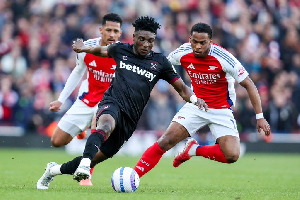I enjoyed reading the second quarter edition of the HR magazine which had the caption; “When the youth breaks the Ghanaian leadership myth”. The likes of Carl Ashie (Brain behind Zain Ghana’s Zap) and Fred Swaniker (CEO of African leadership Academy in Johannesburg South Africa) offered me so much inspiration about the new leadership paradigm which some of us have been campaigning for. Indeed the young people in our country must be given a chance to bring new initiatives on board. The entrepreneurial passion and dedication towards public service must be given more support than never before. One of the critical factors in growing world class citizens is to start teaching our young people what it takes to manage a real world class organization-leadership.
I will therefore sketch what I call the contours of leadership: THE ART OF LEADING A TEAM. Since every one is created unique, divergent leadership styles shoot up any time a group is put under the supervision of a manager. Therefore before any group can perform, their knowledge about the kind of persons who lead them and how to work well with them becomes inevitable.
There may be several styles of leadership depending upon how one may look at it. However I would like us to consider four outstanding ones. These are the analyst and architect, driver, relationship master and spontaneous motivator styles of leadership. In order for us to grasp these leadership styles without even a sigh, let’s treat them separately.
ANALYST AND ARCHITECT
How do I know if a leader is an analyst or architect? Straightforward! The strengths of Analysts and architects are:
? Information and opinion seekers
? Good at analysis and process observation
? Prefer to make decisions based on facts
? Prefer as much information as possible before deciding
? Can come out with totally “off the wall” solutions that work
? Translate feelings and experiences into ideas.
Nevertheless, this style of leadership has its own weaknesses. Since they (Analysts and architects) often rely on enough information as possible before making decisions, they can be very slow in making decisions or bogged down by facts. In the same vain, they can focus on one decision at the expense of others. If a leader has this style, members in a group should endeavor to honor their need for information while also requesting them to tell you how they will decide or delegate and when. Although this style is essential (as significant learning comes through observation and analysis), too much of it in a group allows opportunity to pass. This is as a result of the laissez-faire (liberal) attitude in the group in allowing prolonged discussion and analysis. People who have this style of leadership are cautioned to watch out for non involvement or unrealistic ideas if they get into their own world.
DRIVER
Does the name alone suggest something to you about this style of leadership? I believe your guess is as good as mine. Drivers are for their strengths:
? Information and opinion givers
? Easy at making decisions
? Often the keeper of the vision in a group
? Great at taking a stand, being direct, and making things happen
? Usually not shaken too much by critical feedback
The challenge here is that drivers often will urge “let’s decide” and may therefore decide without the input of the group and hurt feelings. Similarly they may make mistakes when moving too fast without adequate information. They may also loose connection with a group since they tend to be impersonal. Persons who fall within this quadrant should be careful not to “over lead” as it will spark some of the consequences enumerated above. When working with a leader in this category, members in a group should be as direct as possible; bringing problems and opinions to them as they expect this. When this style is not mature there may be individuality. Turf battles of group member autonomy and collaboration may ensue.
RELATIONSHIP MASTER
This style of leaders emphasizes caring functions and their strengths include:
? Excellent at building and sustaining a community
? Work well on a team
? Great at building rapport, consensus, commitment
? Actively seeks feedback
? Supports, praises, and demonstrates concern for others
? Displays a high regard for other people’s wishes, views, and actions
The challenge over here is that a this type of leader may avoid taking an unpopular stance if it puts a relationship at risk; emphasizing so much on relationship building and community at the expense of decision- making. If a leader has this style, you may need to be more specific in outlining their expectations. Encourage critical feedback from them and tell them when you want to know what they think. Relationship masters bring caring and respect to a group, which is essential connective glue for a functional group. However, if it is the only style the group has, however, the group may not take enough risks or make enough decisions to move forward significantly. Leaders who fall in this category should be careful not to downplay their own needs their own detriment. When combined with other leadership qualities, these leadership qualities are most powerful.
SPONTANEOUS MOTIVATOR
A spontaneous motivator gives emphasis to emotional stimulation functions. Leaders who fall in this quadrant are:
? Willing to voice their ideas and supply passion to others to follow those ideas: energize a group.
? Great at motivating people as they have a sense of mission or vision
? Good at energetic dialogues with other group members.
The challenge here is that such leaders are emotionally bound to their ideas; objectivity can be their biggest challenge and can create a highly emotionally charged climate if they put too much emphasis on challenging others and confronting assumptions. When working with these types of leaders, members in such groups should not be afraid to voice their stance or position on issues that crop up in the group. Spontaneous motivators are often light bulbs. Groups need this function to sparkle, create, prod, stir the pot, and impassion. This is highly effective. If too much of this style is present in a leader, a group can be overly reactive or so impassioned around their ideals that lose touch with other realities.
Indeed there has never being a generation of young people with more potential for exploits than this generation. Although the leadership voyage is not easy, persistence can make it possible.
First have a vision of what you want to be before leaving the corridors of this institute: for vision is the source and hope of life. Vision sets you from the limitations of what the eyes can see and allows you to enter into the liberty of what the heart can feel. Again, be determined. Determination makes you continue trying to do something even when it is difficult. Finally have courage! Courage makes you face opposition and pain without entertaining fear.
Again, let the words of Robert Schuler resound from your lips that; “I will! I am! I can! I will actualize my dream. I will press ahead; I will settle and see it through. I will never walk away from my dream until I see my dream walks away: Alert! Alive! Achieved!
Courtesy: Gyan EnocK
The writer is the leader of Orange Education Ghana- an NGO towards spearheading a Robust Pan African education.
Email: gyanenock@yahoo.co.uk
Opinions of Sunday, 3 October 2010
Columnist: Gyan, EnocK






![Former President Akufo-Addo [L] and Okatakyie Afrifa Mensah Former President Akufo-Addo [L] and Okatakyie Afrifa Mensah](https://cdn.ghanaweb.com/imagelib/pics/587/58758132.295.jpg)











